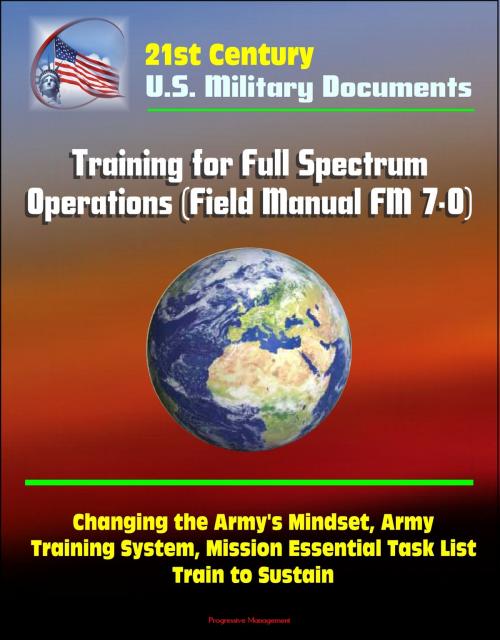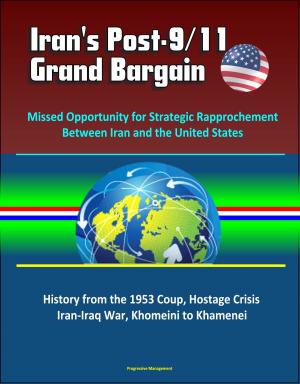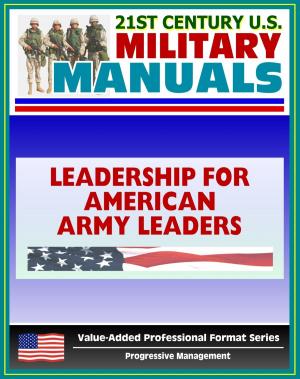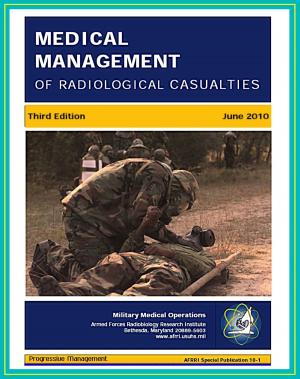21st Century Military Documents: Training for Full Spectrum Operations (Field Manual FM 7-0) - Changing the Army's Mindset, Army Training System, Mission Essential Task List, Train to Sustain
Nonfiction, History, Military, United States| Author: | Progressive Management | ISBN: | 9781311029867 |
| Publisher: | Progressive Management | Publication: | January 24, 2015 |
| Imprint: | Smashwords Edition | Language: | English |
| Author: | Progressive Management |
| ISBN: | 9781311029867 |
| Publisher: | Progressive Management |
| Publication: | January 24, 2015 |
| Imprint: | Smashwords Edition |
| Language: | English |
FM 7-0, Training for Full Spectrum Operations, establishes the Army's keystone doctrine for training. Since FM 7-0 was last published, enough has changed in the nature of operational environments worldwide to merit a full review of its content and form. FM 7-0 is the guide for Army training and training management. It addresses the fundamental principles and tenets of training. It addresses the fundamentals of training modular, expeditionary Army forces to conduct full spectrum operations—simultaneous offensive, defensive, and stability or civil support operations—in an era of persistent conflict. Conducting effective training for full spectrum operations must be a top priority of senior leaders during both force generation and operational deployments. FM 7-0 incorporates new tenets for training modular organizations to conduct full spectrum operations. However, the manual has further developed the concepts in the 2002 version as well. The Army must not lose the many sound training practices used before 11 September 2001. In addition, the manual emphasizes that commanders should leverage the combat experience of seasoned individuals and their leaders in developing training plans. FM 7-0 cannot answer every training challenge of today's complex operational environments. It should, however, generate reflection and introspection on how Soldiers and units train for full spectrum operations as an expeditionary Army.
Chapter 1 - TRAINING FOR FULL SPECTRUM OPERATIONS—CHANGING THE ARMY'S MINDSET * The Strategic Landscape * Effects of Today's Operational Environments * The Role of Training * Meeting the Challenges of Full Spectrum Operations * Implications of the Aim Point on Training and Leader Development * Chapter 2 - PRINCIPLES OF TRAINING * Training Concept * Commanders and Other Leaders Are Responsible for Training * Noncommissioned Officers Train Individuals, Crews, and Small Teams * Train as You Will Fight * Train to Standard * Train to Sustain * Conduct Multiechelon and Concurrent Training * Train to Develop Agile Leaders and Organizations * Chapter 3 - THE ARMY TRAINING SYSTEM * Foundations of Army Training * Training and Education * Training and Education Lifecycle of Soldiers and Army Civilians * Foundations of Leader Development * Training Domains * Chapter 4 - ARMY TRAINING MANAGEMENT * Section I - Training Management in the Modular Force * Army Force Generation Drives Training Management * The Modular Force's Effect on Training Management * Leader Roles in Training Management * Army Forces and Joint Training * Section II - Mission-Essential Task List Development * Mission Focus * Mission-Essential Task Lists * Section III - The Army Training Management Model * Top-Down/Bottom-Up Approach To Training * Plan * Prepare * Execute * Assess * GLOSSARY * REFERENCES
Chapter 1 discusses the environment in which training and operations occur. It stresses the need for the Army to prepare for full spectrum operations. The chapter concludes by discussing the aim point concept used to focus training on the most likely operational environments.
Chapter 2 focuses on the Army's seven principles of training and the supporting tenets that apply at all organizational levels and across all components.
Chapter 3 describes the Army Training System, defines training and education, describes the three training domains, and provides a brief discussion of leader development.
Chapter 4 describes Army training management. It begins by describing the effects of Army force generation and modular organizations on training management. Then it addresses how to develop the mission-essential task list. The bulk of the chapter discusses how to use the Army's training management model to plan, prepare, execute, and assess training.
FM 7-0, Training for Full Spectrum Operations, establishes the Army's keystone doctrine for training. Since FM 7-0 was last published, enough has changed in the nature of operational environments worldwide to merit a full review of its content and form. FM 7-0 is the guide for Army training and training management. It addresses the fundamental principles and tenets of training. It addresses the fundamentals of training modular, expeditionary Army forces to conduct full spectrum operations—simultaneous offensive, defensive, and stability or civil support operations—in an era of persistent conflict. Conducting effective training for full spectrum operations must be a top priority of senior leaders during both force generation and operational deployments. FM 7-0 incorporates new tenets for training modular organizations to conduct full spectrum operations. However, the manual has further developed the concepts in the 2002 version as well. The Army must not lose the many sound training practices used before 11 September 2001. In addition, the manual emphasizes that commanders should leverage the combat experience of seasoned individuals and their leaders in developing training plans. FM 7-0 cannot answer every training challenge of today's complex operational environments. It should, however, generate reflection and introspection on how Soldiers and units train for full spectrum operations as an expeditionary Army.
Chapter 1 - TRAINING FOR FULL SPECTRUM OPERATIONS—CHANGING THE ARMY'S MINDSET * The Strategic Landscape * Effects of Today's Operational Environments * The Role of Training * Meeting the Challenges of Full Spectrum Operations * Implications of the Aim Point on Training and Leader Development * Chapter 2 - PRINCIPLES OF TRAINING * Training Concept * Commanders and Other Leaders Are Responsible for Training * Noncommissioned Officers Train Individuals, Crews, and Small Teams * Train as You Will Fight * Train to Standard * Train to Sustain * Conduct Multiechelon and Concurrent Training * Train to Develop Agile Leaders and Organizations * Chapter 3 - THE ARMY TRAINING SYSTEM * Foundations of Army Training * Training and Education * Training and Education Lifecycle of Soldiers and Army Civilians * Foundations of Leader Development * Training Domains * Chapter 4 - ARMY TRAINING MANAGEMENT * Section I - Training Management in the Modular Force * Army Force Generation Drives Training Management * The Modular Force's Effect on Training Management * Leader Roles in Training Management * Army Forces and Joint Training * Section II - Mission-Essential Task List Development * Mission Focus * Mission-Essential Task Lists * Section III - The Army Training Management Model * Top-Down/Bottom-Up Approach To Training * Plan * Prepare * Execute * Assess * GLOSSARY * REFERENCES
Chapter 1 discusses the environment in which training and operations occur. It stresses the need for the Army to prepare for full spectrum operations. The chapter concludes by discussing the aim point concept used to focus training on the most likely operational environments.
Chapter 2 focuses on the Army's seven principles of training and the supporting tenets that apply at all organizational levels and across all components.
Chapter 3 describes the Army Training System, defines training and education, describes the three training domains, and provides a brief discussion of leader development.
Chapter 4 describes Army training management. It begins by describing the effects of Army force generation and modular organizations on training management. Then it addresses how to develop the mission-essential task list. The bulk of the chapter discusses how to use the Army's training management model to plan, prepare, execute, and assess training.















